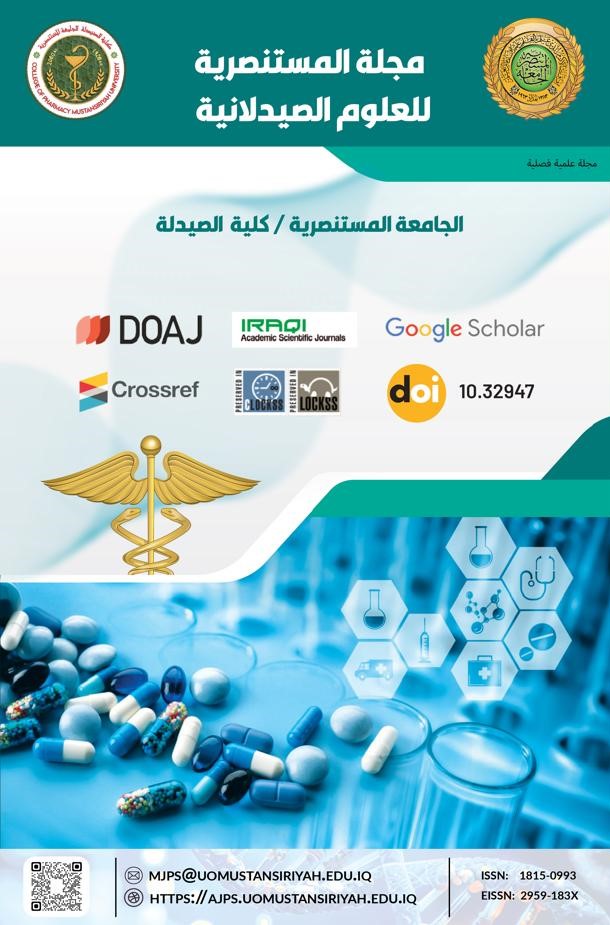Prevalence and identification of Bacillus species in cellophane, foil, and disposable plastic containers used for food packaging
DOI:
https://doi.org/10.32947/ajps.v24i4.1196Keywords:
Foil, Cellophane, Disposable plastic container, Food packaging, Family BacillaceaeAbstract
Background: Foil, cellophane, and disposable plastic containers are commonly employed in food packaging, namely as coatings on food items. Nevertheless, the existence of microbes on the surface and inside the internal composition of these materials gives rise to concerns, as they have the capacity to multiply under ideal circumstances and spread to food items, thereby jeopardizing the safety and quality of the food.
Objective: This study aimed at examining the number of microorganisms and identifying specific bacterial species within frequently used food packaging materials like foil, cellophane, and disposable plastic containers.
Methods: samples of foil, cellophane, and disposable plastic containers were collected from various popular brands in Iran. The overall bacterial count wضas determined using defibering, flooding, and smear techniques followed by culturing on Tryptone Glucose Extract Agar (TGEA) medium. To identify the bacterial species, various biochemical tests were performed, including fermentation, motility testing, catalase test, oxidase test, and methyl red-Voges Proskauer (MR-VP) test.
Results: Bacterial quantity ranged from 0 CFU/g to 8.3 × 103 CFU/g in analyzed samples. All the samples had primary contaminants mainly Bacillaceae family bacteria that could produce spores. Disposable plastic containers had the lowest bacterial count whereas cellophane showed the highest bacterial contamination level. Among Bacillaceae family members Bacillus licheniformis was dominant.
Conclusion: The study's findings emphasize the possibility of microbial contamination in food packaging materials, including cellophane. These results indicate that the food packaging industry should adopt a rigorous approach to hazard evaluation and Important Control Points (HACCP) in order to guarantee the microbiological safety and efficacy of packaging materials.
References
- Lamberti M. and Escher F.. Aluminium foil as a food packaging material in comparison with other materials. Food Reviews International 2007;23(4):407-433. DOI: https://doi.org/10.1080/87559120701593830
- Lewis L. and Christensen A.. Effects of aluminum foil packaging on elemental analysis of bone,. Journal of Forensic Sciences 2015;61(2):439-441. DOI: https://doi.org/10.1111/1556-4029.12994
- Barrios C.. Pressure sensitive adhesive tape: a versatile material platform for optical sensors. Sensors 2020;20(18):5303. DOI: https://doi.org/10.3390/s20185303
- Lafeuille J., Buniak M., Vioujas M., & Lefevre S.. Natural formation of styrene by cinnamon mold flora. Journal of Food Science 2009;74(6). DOI: https://doi.org/10.1111/j.1750-3841.2009.01206.x
- Vazifeh M. , Hosseini M. , Mohammadi A. , Jahanfar M. , & Maleki H.. Evaluation of antimicrobial effects of gouda cheese wax. Medical Laboratory Journal 2021;15(2):18-22. DOI: https://doi.org/10.52547/mlj.15.2.18
- Vasile C. and Baican M.. Progresses in food packaging, food quality, and safety—controlled-release antioxidant and/or antimicrobial packaging. Molecules 2021;26(5):1263. DOI: https://doi.org/10.3390/molecules26051263
- Iversen L. , Rovina K. , Vonnie J. , Matanjun P. , Erna K. , ‘Aqilah N. et al.. The emergence of edible and food-application coatings for food packaging: a review. Molecules 2022;27(17):5604. DOI: https://doi.org/10.3390/molecules27175604
- Putri N., Rhamadani A., & Wisnel W.. Designing food safety standards in beef jerky production process with the application of hazard analysis critical control point (haccp). Nutrition & Food Science 2019;50(2):333-347. DOI: https://doi.org/10.1108/NFS-04-2019-0139
- Igbonekwu C., Ihekwereme C., Oli A., Erhirhie E., Igbokwe N., Ofomata C.et al.. Effects of packaging material on microbial load and safety of ready–to-eat voandzeia subterranean cake (okpa). GSC Advanced Research and Reviews 2022;12(3):087-093. DOI: https://doi.org/10.30574/gscarr.2022.12.3.0235
- Institute of Standards and Industrial Research of Iran (ISIRI). (2022). Microbiology of pulp, paper, and board. National Standard No. 4782-1. URL: https://standard.inso.gov.ir/StandardView.aspx?Id=47010. Pdf. Accessed 2 August 2023.
- Crobiological examination. National Standard No. 8784-1. URL: https://www.iso.org/standard/53064.html. Pdf. Accessed 2 August 2023).
- (Deutsches Institut für Normung (DIN). (2021). Estimation of total bacteria and fungi number in paper products. National Standard No. 54378. URL: https://www.en-standard.eu/din-54378-testing-of-paper-and-board-determination-of-the-surface-colony-count-okz-index-s/.Pdf. Accessed 2 August 2023).
- Bergey’s manual® of systematic bacteriology. 2005.
- Eid N., Doghaither H., Kumosani T., & Gull M. Diversity, physiochemical and phylogenetic analyses of bacteria isolated from various drinking water sources. Pakistan Journal of Medical Sciences 2017;33(3). DOI: https://doi.org/10.12669/pjms.333.12347
- Ibraheem K. Antimicrobial activity of extracts bacillus species isolated from baghdad soil against some human pathogenic microorganisms. Al Mustansiriyah Journal of Pharmaceutical Sciences 2016;16(2):82-87. DOI: https://doi.org/10.32947/ajps.v16i2.114
- Raheem D. Application of plastics and paper as food packaging materials? an overview. Emirates Journal of Food and Agriculture 2013;25(3):177. DOI: https://doi.org/10.9755/ejfa.v25i3.11509
- Singh A., Ramakanth D., Kumar A., Lee Y., & Gaikwad K. Active packaging technologies for clean label food products: a review. Journal of Food Measurement and Characterization 2021;15(5):4314-4324. DOI: https://doi.org/10.1007/s11694-021-01024-3
- Marsh K. and Bugusu B... Food packaging—roles, materials, and environmental issues. Journal of Food Science 2007;72(3). DOI: https://doi.org/10.1111/j.1750-3841.2007.00301.x
- Al-Musawi M., Al-Rubaye M., & Hosseini M. Culture and molecular detection of staphylococcus aureus in dairy products of ahwaz. Al Mustansiriyah Journal of Pharmaceutical Sciences 2014;14(2):103-107. DOI: https://doi.org/10.32947/ajps.v14i2.152
Downloads
Published
Issue
Section
License
Copyright (c) 2024 Mojtaba Mohammadzadeh Vazifeh, Erfan Aghajani, Negin Shokrollahzadeh, Helia Rahmati, Nakisa Sohrabi Haghdoost

This work is licensed under a Creative Commons Attribution 4.0 International License.



















